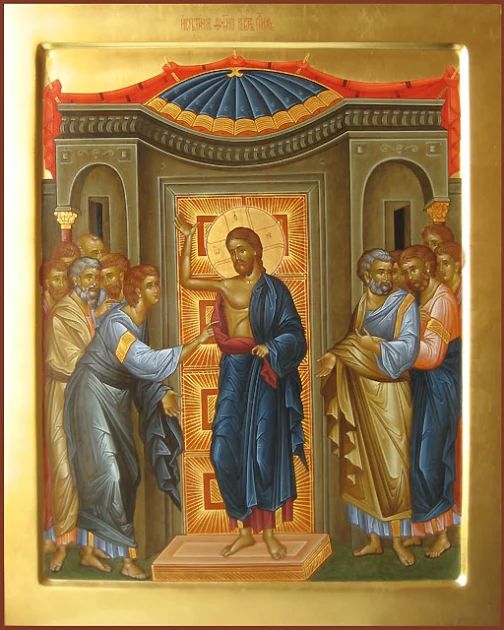
Sunday of Divine Mercy
Gospel according to John 20:19-31
On the evening of that first day of the week, when the doors were locked, where the disciples were, for fear of the Jews, Jesus came and stood in their midst and said to them, “Peace be with you.” When he had said this, he showed them his hands and his side. The disciples rejoiced when they saw the Lord. Jesus said to them again, “Peace be with you. As the Father has sent me, so I send you.” And when he had said this, he breathed on them and said to them, “Receive the Holy Spirit. Whose sins you forgive are forgiven them, and whose sins you retain are retained.” Thomas, called Didymus, one of the Twelve, was not with them when Jesus came. So the other disciples said to him, “We have seen the Lord.” But he said to them, “Unless I see the mark of the nails in his hands and put my finger into the nailmarks and put my hand into his side, I will not believe.” Now a week later his disciples were again inside and Thomas was with them. Jesus came, although the doors were locked, and stood in their midst and said, “Peace be with you.” Then he said to Thomas, “Put your finger here and see my hands, and bring your hand and put it into my side, and do not be unbelieving, but believe.” Thomas answered and said to him, “My Lord and my God!” Jesus said to him, “Have you come to believe because you have seen me? Blessed are those who have not seen and have believed.” Now Jesus did many other signs in the presence of his disciples that are not written in this book. But these are written that you may come to believe that Jesus is the Christ, the Son of God, and that through this belief you may have life in his name.

Reflections
It was the evening of the first week, the end of the day after Jesus had resurrected from the dead. The time of the day, evening, sets the scene for the darkness, within which context we encounter the Light of the Word. In the twilight, while the door where the apostles had stayed had been shut in fear of the authorities, Jesus came and stood among them, defying the darkness of their understanding. He showed them his side which had been pierced with the spear, and his hands, on which the wounds made by the nails were still clearly visible (John 20:20). He supernaturally entered their literal darkness behind the closed doors and figuratively penetrated the darkness of their minds clouded by sorrow, fear and grief, and appealed to them: “’…do not doubt, but believe’” (John 20:27). The second time, a week later, Jesus re-appeared to them again and, knowing that Thomas was not with them the first time and was still doubting, asked him to touch his side and see the wounds on his hands. We do not find evidence that Thomas needed to touch to believe because his reply was, “My Lord and my God!” (John 20:28). This sudden revelation, this sudden recognition of the Lord is like a ray of illumination, a cognizance of the Lord’s presence. Mindful of us, who do not have such firsthand evidence, John adds what Jesus said to Thomas: “’Blessed are those who have not seen and yet have to come to believe’” (John 20:29).
How is it possible to come to believe without being an eyewitness of Jesus’ resurrection? Maybe we should ask this question the other way: “How is it possible to not have come to believe for those who have been eyewitnesses of Jesus’ presence?” There are many explanations that we may be able to give why; despite witnessing the miracles, some chose not to follow Jesus. Yet, again, from another angle, it is perhaps a miracle how many people did follow Jesus despite the persecutions. The disciples were among them. In a moment of zeal, Peter promised to Jesus, “Even if all fall away on account of you, I never will" (Matthew 26:33) and then denied knowing Jesus three times (John 18:15-18). But then, it was Peter, who, with the grace of the Holy Spirit, stood in front of the assembled crowds and announced Jesus’ death and resurrection (Acts 2:14-36). Through the guidance of the Holy Spirit, God’s grace was crucial in helping the apostles take heart and heed Jesus’ instructions: “’As the Father has sent me, so I send you’” (John 20:21). Jesus sent forth the disciples, not alone, but with the power of the Holy Spirit, and He gave them authority to forgive sins: “If you forgive the sins of any, they are forgiven; if you retain the sins of any, they are retained.” (John 20:23) This commissioning is known as the institution of the priestly ministry, through which the administration of the sacraments, such as the Sacrament of Reconciliation, has been passed down since the time of the apostles.
The forgiveness of sins is significant because it gives the apostles the mission to be instruments in restoring a damaged or severed relationship with God which occurs as a result of sin. In the teaching of the Catholic church, sin is an offense against reason, truth and right conscience; it is a failure in genuine love for God and neighbor” (1) There are two types of sins. Minor sins, or so-called venial sins, and major sins, or grave sins. (2) Venial sins affect the self, others, and wounds our relationship with God, and which can be repaired by recognizing them, apologizing, and reparation, and which may be resolved with an act of reconciliation during the Holy Mass, prayers, and supplications and encounters with others. (2) Serious or grave sins go against the law of God. In the case of committing a grave sin, one must have had knowledge that one trespassed the law of God and have acted deliberately to commit an offence that directly offended the laws of God and severe our relationship with God. (2) The Catholic Church names the nature of grave sins, such as murder (CCC 2268), sacrilege (CCC 2120), blasphemy (CCC 2148), perjury (CCC 2152), assisting someone in committing these vices (CCC 2480), but such lists are not exhaustive. (3) Considering the circumstances, acts of commission or omission that do grave injury to the virtues of justice and charity count as serious sins which lead to separation from God. (3) The sacrament of reconciliation has been instituted by Jesus with these words to the apostles out of mercy: Grave sins need to be resolved between the person and God, and one needs to show an expressed desire to restore and to mend what was damaged. Through the sacrament of reconciliation, God grants pardon and forgiveness to restore the relationship and grants grace to mend the hurt that we caused to ourselves and others. (4) The forgiveness of sins involves four parts: (1) contrition (sincere sorrow and recollection of our sins and resolution not to repeat them), (2) confession (naming our sins aloud in front of God), (3) penance (a prayer assigned by a priest offered in reparation for our sins), and (4) absolution (words spoken by a priest which makes it clear that we have been absolved from the sins). (4) A thorough confession always begins with the examination of our conscience and culminates in the rite of the reconciliation granting the Sacrament of Reconciliation. (4) The purpose of reconciliation is to restore what has been broken and to heal what has been wounded. It helps us to draw closer to God in our life’s journey. (5) As Pope Francis expressed it: “When faced with the gravity of sin, God responds with the fulness of mercy. Mercy will always be greater than any sin, and no one can place limits on the love of God who is ever ready to forgive. (5) By entrusting the disciples with this authority, Jesus allows them to be instruments of God’s grace trough signs and gestures to penetrate the heart, the mind and the soul.
Just as the Father anointed Jesus when in his hometown, when he encountered the words of the Scriptures, “…The Spirit of the Lord is on me, because He has anointed me to proclaim good news to the poor. He has sent me to proclaim freedom for the prisoners and recovery of sight for the blind, to let the oppressed go free, to proclaim the year of the Lord’s favor” (Luke 4:18), while they were still in the twilight, Jesus gave the disciples a clear mission: “Go and announce the good news.” (Mark 16:15) This Great Commissioning (Matthew 28:16-20) is repeated in today’s Gospel, and at Pentecost (Acts 2:1-31), where Jesus sends the disciples into the world.
Every Christian is called to be a missionary of the Lord. (6) On World Mission Day, on February 6, 2025, our Pope Francis, who passed away on Easter Monday, reminded us to be Missionaries of Hope Among All People: “’We have been baptized into the redemptive death and resurrection of Christ, into the Passover of the Lord that marks the eternal springtime of history. Consequently, we are ‘springtime people,’ brimming with hope to be shared with all, since in Christ ‘we believe and know that death and hate are not the final word pronounced on human existence (cf. Catechesis, 23 August 2017) []…So let us renew the mission of hope, starting from prayer, especially prayer based on the word of God and particularly the Psalms, that great symphony of prayer whose composer is the Holy Spirit (cf. Catechesis, 19 June 2024). The Psalms train us to hope amid adversity, to discern the signs of hope around us, and to have the constant ‘missionary’ desire that God be praised by all peoples (cf. Ps 41:12; 67:4). By praying we keep alive the spark of hope lit by God within us, so that it can become a great fire, which enlightens and warms everyone around us, also by those concrete actions and gestures that prayer itself inspires’” (7)
Sources
- CCC (2025). Article 1849. The Definition of Sin. Retrieved from: www.vatican.va. Accessed: April 23, 2025.
- Lloyd, G. (2025). Two Types of Sin. Retrieved from: wwwguslloyd.com. Accessed: April 23, 2025.
- Heschmeyer, J. (2024). Mortal Sin: The Basics. Retrieved from: www.catholic.com. Accessed: April 23, 2025.
- Catholic Diocese of Broken Bay (2025). Reconciliation: A Short Guide. Retrieved from: www.bbcatholic.org.au. Accessed: April 23, 2025.
- Pope Francis (2015). Bull of indiction of the Extraordinary Jubilee of Mercy (11 April 2015). Misericordiae Vultus, 3. Retrieved from: www.vatican.va Accessed: April 23, 2025.
- Wooden, C. (2019). Pope: Every Christian is called to be a missionary. The Arlington Catholic Herald. Retrieved from: www.catholicherald.com. Accessed: April 23, 2025.
- Pope Francis (2025). Message of the Holy Father for World Mission Day 2025. Retrieved from: www.catholicmission.org.au Accessed on: April 23, 2025.